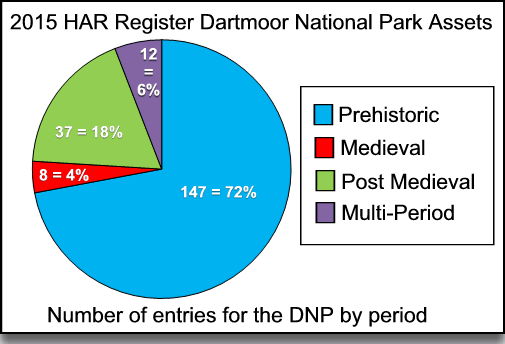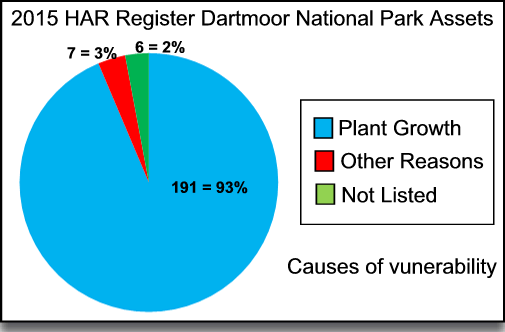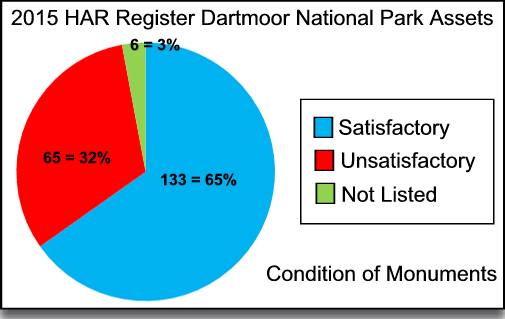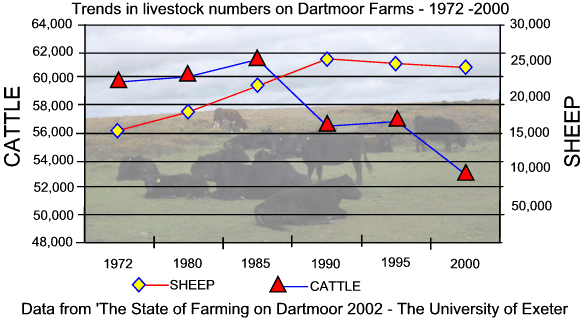
Not long ago I wrote a webpage on the ‘Archerton Camp‘ and whilst doing the research I found that the prehistoric settlement appeared on the ‘Heritage At Risk Register‘. As I was not sure exactly what this was and what it entailed I dug a little deeper. Around about the same time the Western Morning News published an article about the 2015 assessment of the South Western HAR register which deepened my interest.
So here are some basic facts and figures concerning Devon and more importantly Dartmoor from the register. The Heritage at Risk Register (HAR) was first set up in 2008 and its purpose was to identify historic sites that are at risk at being lost due to neglect, decay, or inappropriate development. The register is annually updated by Historic England thus giving a ‘dynamic picture’ of those sites most at risk and therefore which need safeguarding for future generations. The register encompasses the following categories of sites; buildings and structures, places of worship, archaeological sites, conservation areas, registered parks and gardens, registered battlefields and shipwrecks. In 2015 there were 5,534 designated assets on the national Heritage at Risk Register with 604 being removed since 2014 and 327 added in 2015.
In the case of Devon there are currently 447 sites listed on the Heritage at Risk Register of which 348 are scheduled monuments, 86 are listed buildings, 10 are conservation areas and 3 are registered parks and gardens. Of the 348 scheduled monuments listed in Devon 204 of them are located within the bounds of the Dartmoor National Park which equates to 58.6% of the entries. These 204 listings comprise of the following periods of time:

The prehistoric assets consist of settlements, hut circles enclosures, pounds, field systems, reaves, cairns, kists, stone alignments or a mixture of several different prehistoric monuments. The medieval listings are comprised of settlements, farmsteads, deserted medieval settlements and churches. The post-medieval entries in the main are features of rabbit warrens; pillow mounds, vermin traps and warren houses. Also included are relics of the tin industry: stream works, a blowing house, a bridge a church and a socket stone of a cross. The multi-period assets are a mixture of all the above historic periods.
The alarming fact regarding the listed assets is the cause of their vulnerability and concern. By far the biggest threat comes from plant growth. In the case of the prehistoric monuments 143 out of 147 at at risk from plant growth damage. The biggest culprit here is bracken with a little help from gorse. Out of the 4 not regarded as being damaged by plant growth 1 is at risk from animal burrowing, 2 from scrub and tree growth and 1 from forestry activity.

Out of the 8 medieval assets 3 are at risk from plant growth, 1 from tree and scrub growth and the remaining 4 have no cause listed and are the churches. In the case of the post-medieval assets 32 are at risk from plant growth, 1 is vulnerable to erosion, and have no reason given. All of the 12 multi-periods entries are listed as being vulnerable to plant growth. It is also interesting to note that out of the total 204 assets appearing on the HAR register all but 2 are regarded as being in a declining condition.
The register also defines the condition of each monument as being either; “satisfactory with significant local problems,” or “unsatisfactory with major local problems.” When these listings are analysed the following result is reached; there are 133 sites in a satisfactory condition, 65 in an unsatisfactory condition and 6 not listed.

On Dartmoor by far the biggest threat is from bracken which is especially relevant to the prehistoric monuments located on the open moor. There have been various methods tried to control the spread; aerial spraying, bashing, cutting, rolling and grazing all with varying short-term success. For centuries one effective method of bracken control was that provided by livestock but as their numbers reduce so does the control.
At one time the numbers of livestock grazing the moor was much higher than it is today with numbers being restricted for ecological reasons. Prior to the foot and mouth outbreak of 2001 the cattle and sheep numbers found on Dartmoor farms was declining as can be seen from the graph below.

The above data shows the livestock numbers belonging to total number of farms on Dartmoor and does not necessarily mean that all of them were grazing on the moor. It does however reflect an overall decline in numbers prior to foot and mouth. Following the outbreak the livestock numbers have continued to fall over the following 14 years. A report issued by EBLEX in 2011 notes that since the year 2000 livestock numbers grazing Dartmoor have fallen by 25% with the sheep flock dropping by 31% and cattle headage by 17%.
The previously higher numbers of grazing sheep, cattle and ponies meant that the spread of bracken was reduced either by eating or trampling. Additionally in decades gone by many of the moorland farmers would cut the bracket to use as winter bedding which again had some degree of control. During the summer months the Dartmoor Preservation Association organise days of ‘bracken bashing’ whereby gangs of volunteers venture out onto various bracken infested areas of the moor.

As with any dataset the numbers can be read in various ways and the ‘Heritage At Risk Register’ is no exception. As noted above the percentage of assets on Dartmoor seem alarmingly high when compared to the rest of Devon. However, it is worth noting that when that percentage is compared against the number of monuments in total upon the moor things aren’t quite as bad as they seem. Additionally there are bound to be many more monuments in existence on Dartmoor because as with the lowlands of Devon agricultural activities have obliterated them. So it is not all doom and gloom but hopefully the above has highlighted that if something is not done about the condition and vulnerability of these ancient sites many more will be damaged.
 Legendary Dartmoor The many aspects past and present of Dartmoor
Legendary Dartmoor The many aspects past and present of Dartmoor
